 |






|
- Area: 83,8 sq. km
- Area of Metropolitan Lisbon: 2 700 sq. km
- Population in 1991: 660 000 inhabitants
- Estimated Population in 1998: 535 740
inhabitants
- Population Density: 78,7 inh./ha
- Number of Parishes: 53
- Total Area of Green Spaces: 22,5 sq. km
- Number of Dwellings (1991): 278 000
- Number of Jobs: 522 000
- Number of Cars: 400 000
|
| A new cycle of council administration was seen in Lisbon
after 1990 www.cm-lisboa.pt which at
the same time developed a strategic plan based on diverse instruments and which took city
development into account. |
Thus, 3 levels of planning were implemented: |
- Strategic Lisbon Plan (1990/1992) - this defined the city
development plan and the city council's activity at urban, environmental, social, economic
and cultural levels. This is an instrument of social-economic character usd as a guide for
the other planning instruments;
|

|
- Master Plan (1990 -1994) - the instrument of support for urban
management intended to find the urban options and concepts formulated in the Strategic
Lisbon Plan, establishing the rules of occupation, use and transformation of the city
council land and safeguarding the environmental, urban and patrimonial components;
|
- Priority Plans and Projects - are instruments that refer to
operational urban interventions within very specific and well defined boundaries, which
are intended to enhance the city and the urban environment (urban rehabilitation,
eradication of slum housing, green space, equipment, cleansing of the Tagus, application
of the 3 Rs policy, treatment of solid urban waste, etc.).
|
| As from 1990 the city council administration developed an
"Idea of the City" that was to implement a strategy that looked for the paradigm
of sustainable development from an urban point of view, with special attention being paid
to the resolution of serious structural asymmetries. |
| IDEA OF THE
CITY |
LISBON,
PEOPLE’S CITY
THE CITY OF SOLIDARITY
LISBON, THE "OPEN CITY"
CITY OF QUALIFIED SERVICES
METROPOLIS CAPITAL
RIVERSIDE CITY
CITY OF NEIGHBOURHOODS |
| PEL, 1992 |
- Lisbon, People’s City; The City of Solidarity
Promotion of a "New Homes in Lisbon" programme as an aid to the construction
of new houses and the recovery of buildings, with attractive and accessible conditions for
young people.Construction of meeting places for young people and the elderly (Youth
Centres and Day Centres)
|
Co-ordinate the progressive elimination of architectonic
barriers not just from the public highways, services and establishment, but also at the
level of housing, transports and communications, to name but a few.
Improve the quality of life of the population through improved safety conditions,
comfort and urban design in public spaces.
|
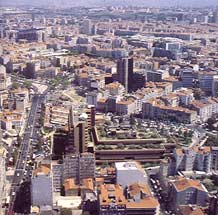
|
- City of qualified services; Metropolis Capital
Attract specialist and qualified functions to stimulate the role of the capital in the
country and in the ranking of European capitals at the same time.
|
Link the city to the river through the introduction of new urban uses - restaurant
services and cultural functions, and at the same time reinforcing the strategic role of
the port in the country's economy.
|
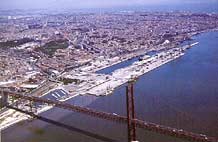 |
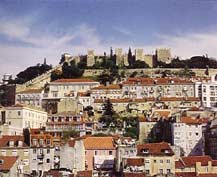 |
|
Pronunciation of the Plans
Following the Aalborg Conference of 1994, Lisbon received the 2nd
Conference on Sustainable Cities and Towns in 1996, at which the LISBON ACTION PLAN was
presented. This plan of action was the instrument used to develop the process followed by
the local authorities after the Earth Conference held in Rio de Janeiro in 1992 - Local
Agenda 21.
In 1992 the Strategic Plan for Lisbon already included the Urban Environment Charter as
an instrument of environmental and social-economic integration instrument. In fact the
Lisbon Urban Environment Charter is an innovative instrument in terms of city planning and
management, with a set of pre-defined objectives together with protection and improvement
measures in line with the city project which was adopted in 1990.
|
| URBAN
ENVIRONMENT CHARTER |
| OBJECTIVES |
ENVIRONMENTAL COMFORT
USE AND APPROPRIATION OF THE CITY
SAFETY WHEN USING THE CITY
STRENGTHENING CITY IDENTITIES
|
| PROPOSALS AND
PROGRAMMES |
PUBLIC SPACE
GREEN STRUCTURE OF THE CITY
URBAN LANDSCAPE ELEMENTS AND ROUTES
AIR, WATER, NOISE, CLEANING
RESIDENTIAL NEIGHBOURHOODS
RESTORING BUILDINGS
URBAN FABRIC TO BE STABILISED
AESTHETIC AND ARCHITECTURAL QUALITY OF CONSTRUCTIONS
CRICAL AREAS AND SITUATIONS TO BE RESOLVED
ROAD MANAGEMENT
PUBLIC PARTICIPATION
|
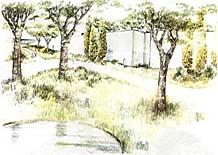 |
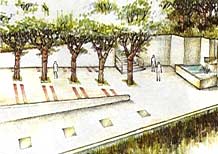 |
In 1996 the Lisbon Plan of Action consolidated the directives of the Lisbon Environment
Charter, aimed at developing local experiences in order to prepare the City Council and
other diverse community sectors for the importance of their role as stimulators in the
qualification of the urban environment. The main objective was to lay down the necessary
synergies through the adoption of "co-operation" and "partnership"
actions. Thus the Integrated Plan of Environmental Quality/Local Agenda 21 came into
being, and which is to be carried out through the convergence of the subsidiary principle
with the concept of "shared responsibility". |
This instrument should provide an approach to new moulds of urban 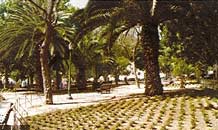 planning based on a
type of management orientated toward aspects of environment and sustainability and not
just the restricted vision of soil use or growth. The identification of environmental
objectives from the very beginning of the planning process, the application of necessary
indicators and principles, the development of forms of participation and active
involvement of the populations and the potential inter-linking of these systems with the
processes of building a Local Agenda 21 are aspects that should be favoured by city
planning policies. planning based on a
type of management orientated toward aspects of environment and sustainability and not
just the restricted vision of soil use or growth. The identification of environmental
objectives from the very beginning of the planning process, the application of necessary
indicators and principles, the development of forms of participation and active
involvement of the populations and the potential inter-linking of these systems with the
processes of building a Local Agenda 21 are aspects that should be favoured by city
planning policies. |
The Integrated Plan of Environmental Quality combines with the Strategic Lisbon Plan and
the Master Plan in the search for a 2nd generation strategic instrument to progressively
implement a sustainable management and development model for the city that will guarantee
improved urban environment in accordance with the principles established by Local Agenda
21. |
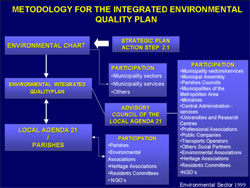
|
The elaboration of the Integrated Plan of Environmental Quality for Lisbon includes
diverse principles that will provide consistency to sustainability in urban areas through
an incremental process:
Urban Management Principle
Ecological, social and economic dimension;
Political Integration Principle
Development of a double network (horizontal and vertical) of municipal administration;
Ecosystemic Reflection of the City Principle
Return to the integrated urban system approach
Co-operation and Partnership Principle
Shared Responsibility |
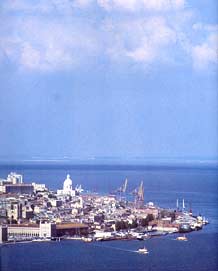 The Integrated
Plan of Environmental Quality for the city of Lisbon is an important medium and long term
operational instrument based on a transverse and collective concept developed by the
Department of the Environment of the Lisbon City Council. This department politically and
functionally unifies all matters concerning urban environment, namely: The Integrated
Plan of Environmental Quality for the city of Lisbon is an important medium and long term
operational instrument based on a transverse and collective concept developed by the
Department of the Environment of the Lisbon City Council. This department politically and
functionally unifies all matters concerning urban environment, namely:
- Environment and Green Spaces; Air Pollution; Combat Against Urban Noise Policy;
Integrated Drainage, Environmental Improvement of the Tagus Estuary and Rational Water
Management System; Integrated Solid Waste Management System; Sanitary and Environmental
Community Awareness and Education; Rational Energy Management; Landscape and Environmental
Qualification of Public Spaces.
|
 At
present Lisbon has more parks, public gardens and green spaces (27m2
of green space per inhabitant), and which are being progressively used more by its
inhabitants. At the same time as this significant increase in green spaces we have also
seen the recovery of public squares, especially those of the Pombaline style in the
Historic Area of the city, and the appearance of new parks in outer city areas. The city
continues to work on policies to reduce atmospheric and noise pollution through the
planting of thousands of trees, situation which also adds additional beauty to the city. At
present Lisbon has more parks, public gardens and green spaces (27m2
of green space per inhabitant), and which are being progressively used more by its
inhabitants. At the same time as this significant increase in green spaces we have also
seen the recovery of public squares, especially those of the Pombaline style in the
Historic Area of the city, and the appearance of new parks in outer city areas. The city
continues to work on policies to reduce atmospheric and noise pollution through the
planting of thousands of trees, situation which also adds additional beauty to the city.
Another of the development actions is involved in the construction of
an Urban Noise Charter for the whole of the city and which will become an important
instrument for future urban interventions resulting in a better quality of life for the
citizens of Lisbon. |
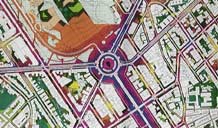 |
At the moment Lisbon is blessed with a modern and efficient pollution reducing system in
the Tagus estuary through the re-use of waste water for secondary uses and an integrated
solid urban waste management system. This is an innovative project that applies the 3Rs
policy - Reduce, Re-use and Recycle - to paper, cardboard cartons, glass and batteries in
a network of 1 000 refuse recycle bins. Mention must also be made of the pioneer
experiment being carried out at national level of collecting cork bottle stoppers with a
view to recycling them - as cork is 100% Portuguese material, 100% natural, 100%
recyclable and 100% ecological.
But even with these and other measures being taken, our main objective in following and
reinforcing our policies is still one of increasing the participation of the local
population and strengthening the values of civism through information, education and
environmental awareness campaigns.
|
| Environmental
and Sanitation Promotion, Awareness and Education Projects |
1. Noise Prevention Campaign
2. Educational Kitchen Vegetable Garden (92/99)
3. Living Green Project (96/98)
4. Information Campaign on Green Spaces
5. Ever Young Environment
6 Act Local, Think Global (98/99)
7. Lisbon in Bloom Programme
8. Awareness - Local Agenda 21 in Europe
9. Environment Education Trainers
10. Ecological Park of Monsanto
11. A Cool Lisbon is a Clean Lisbon (93/98)
12. From School to Pro-Environment School (97/99) |
Ten years of environmental policy in Lisbon represents a pacific revolution that became
possible by the city facing strategic challenges of the XXI century and building a genuine
sustainable programme of day-by-day development for Lisbon and its population.
All of this work can be seen in the exhibition of the project:
"Lisbon, Thriving for a Sustainable Urban Environment" to be presented in the
Global Home at Expo 2000 in Hanover. |
The project sent – Lisbon: Thriving for a Sustainable Urban Environment - integrates
actions (Restructuring and Re-qualification the Urban environment, Environmental Awareness
and education) that have increased the protection and value of the urban environment,
improved the quality of life of its citizens and increased the exercising of democratic
participation. This operation is aimed at sustained development and was accompanied by a
"shared responsibility" situation between the Lisbon City Council, public and
private entities and the citizens of the city themselves. The project is composed of 4
sub-projects, 2 of which are the council's responsibility and 2 in partnership with public
entities the Lisbon Port Authority and Parque Expo 98).
This project was chosen by an international jury to be present at the Hanover 2000
World Fair as being one of the most representative sustainable urban development areas. |
|

